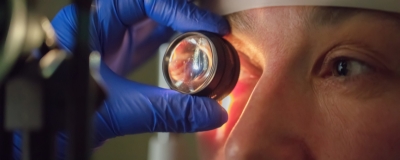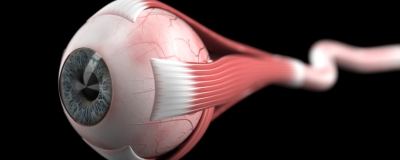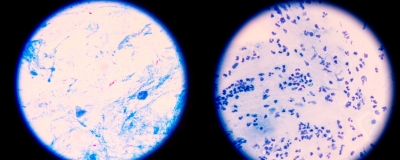
FEATURE

Novel Ocular Implant for Glaucoma Treatment Shows Promising Results
Time to read: 05:03.This study aimed to evaluate the efficacy and safety of PA5108, a biodegradable ocular implant designed to provide sustained drug delivery to glaucoma patients, potentially addressing issues of poor patient adherence to traditional eye drop therapy.
Feature
Text

Stem cell breakthrough: iPSC-Derived corneal transplants show promise in treating vision loss from Limbal Stem Cell Deficiency
Time to read: 03:33. Human iPSC-derived corneal epithelial cell sheets (iCEPS) show promise as a novel regenerative therapy for limbal stem cell deficiency (LSCD), demonstrating significant improvements in corneal health and visual acuity without immunological rejection
Source: The Lancet
Text

Evolving Techniques in Corneal Refractive Surgery: Visual Functions and Anterior Ocular Surface Changes Post-Trans-PRK
Time to listen: 01:30. Trans-PRK is a safe and predictable corneal refractive surgery technique that results in significant improvements in visual acuity and contrast sensitivity. The study confirms favourable outcomes in both visual and tear function metrics over a one-year follow-up period, demonstrating its efficacy for myopic patients.
Source: African Vision and Eye Health
Text

Study reveals vision impairment as a significant contributor to the development of dementia in older adults
Time to read: 01:20. The study found that 19% of dementia cases in older adults are attributable to vision impairments, with contrast sensitivity showing the strongest association. Specifically, 15% of dementia cases were linked to contrast sensitivity impairment, followed by 9.7% from near acuity and 4.9% from distance acuity.
Source: JAMA Ophthalmology
Text

Non-Invasive Pharmacological Treatment Shows Promise in Improving Vision for Early-Stage Cataract Patients
Time to read: 2:19. This study demonstrated that 2.6% EDTA ophthalmic solution (C-KAD) improved contrast sensitivity in patients with early-stage age-related cataracts and may offer a viable non-surgical intervention
Source: Journal of American Ophthalmoloogy
Text

Melatonin may reduce risk of age-related Macular Degeneration
Time to read: 01:19. A recent study published in JAMA Ophthalmology on June 6, 2024 suggests that melatonin supplementation could significantly reduce the risk of developing age-related macular degeneration (AMD) and slow its progression.
Source: JAMA Ophthalmology
Text

Four-Year Progression of Myopic Maculopathy in Children and Adolescents With High Myopia
Time to read:1:13. Macular myopia is one of the top causes of visual impairment globally. By the year 2020 it was estimated that 2.5 billion people were affected by the disease. 27%–33% of these individuals were expected to present with high myopia
Source: JAMA Ophthalmology
Text

Potential Structural Biomarkers in 3D Images Validated by the First Functional Biomarker for Early Age-Related Macular Degeneration – ALSTAR2 Baseline
Time to read: 00:46. This study aims to understand the relationship between delayed rod-mediated dark adaptation (RMDA), a functional biomarker for early age-related macular degeneration (AMD), and the status of outer retinal bands on optical coherence tomography (OCT).
Source: Investigative Ophthalmology & Visual Science
Text

Proof-of-concept and Randomized, Placebo-controlled Trials of an FcRn Inhibitor, Batoclimab, for Thyroid Eye Disease
Time to read: 01.40. This study presents the first results of the proof-of-concept (POC) and randomized, double-blind placebo-controlled trials of batoclimab conducted in patients with moderate-to-severe active TED.
Source: Journal of Clinical Endocrinology & Metabolism
Text

Association of Systemic Medication Use with Glaucoma and Intraocular Pressure
Time to read:01:51. In this recent study, published in Ophthalmology, researchers set out to determine which, if any, of the more commonly prescribed systemic medications was associated with an increased risk for developing raised intraocular pressure and glaucoma.
Source: Ophthalmology
Text

Blood flow in the optic nerve head in patients with primary aldosteronism
Time to read: 01:15. The researchers of this 2023 paper compared blood flow in the optic nerve head (ONH) of patients with primary aldosteronism to those without PA.
Source: PoLS One
Text

Laser in Glaucoma and Ocular Hypertension (LiGHT) Trial: 6 year results
Time to read:01:26. This research extends on the initial results of the 2019 Laser in Glaucoma and Ocular Hypertension (LiGHT) trial.
Source: Ophthalmology
Text

Ocular manifestations of COVID-19 in pediatric patients
Time to read: 01:03. In this narrative review, the authors focus on the ophthalmic manifestations of COVID-19 in children.
Source: Therapeutic Advances in Ophthalmology
Text

Multidrug-resistant keratitis: challenging yet manageable
Time to read: 02:22.This retrospective study set out to review the instances of multi-drug resistant bacterial keratitis presenting a tertiary eye care institute in the eastern part of India over a period of two years (January 2018- December 2019)
Source: British Journal of Ophthalmology
Text

Retinal age gap as a predictive biomarker for mortality risk.
Time to read: 02:22. This study investigated whether there was a correlation between the retinal gap - the difference between the biological age predicted by the model and the patient's chronological age - and increased mortality rate.
Source: British Journal of Ophthalmology
Text


